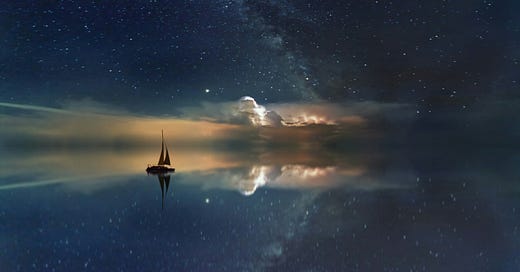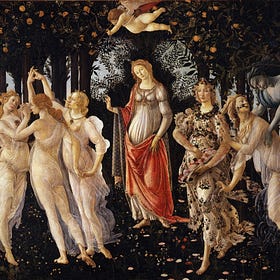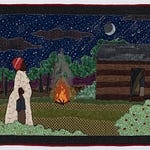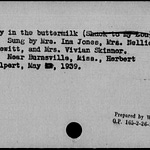1Check out the essay companion to this audio dispatch. It’s full of links, resources, and other reference materials you may find interesting.
Your Fav is Woo: Polaris Manifesto Part 3
Greetings! This is Part 3 in a series about myth, speculative fiction, and social change. Catch up on the rest of the series using the links below.
Transcript
[00:00:00] Welcome to Between Starshine and Clay, a weekly meditation on myth and culture by Jasmyne D. Gilbert. You're listening to the audio companion to my weekly newsletter with the same title.
[00:00:16] Before we get to the recitation, I want to share that my buddy Elyse (
) from Be More Connected has opened doors to The Growth Collective today, February 12th. If you're looking for ways to align your daily life with the rhythms of nature and the elements, you should consider joining the program. To quote her,[00:00:33] "Through the four elements, The Growth Collective creates a space where you can own your power, honor your soul's calling, and transform in community." If you were drawn to this newsletter, you'd probably be really into Elyse's work too. I don't get anything for sharing this information. I just want to support a kind, thoughtful person doing powerful spiritual work in the world. You can learn more about The Growth Collective and Be More Connected on Instagram.
[00:01:16] Alright, let's get to it.
Today's recitation comes from my February 12th, 2025 dispatch called "Your Fav is Woo, Polaris Manifesto Part 3" and it's all about famous people and historical figures that are fans of myth and mysticism.
[00:01:38] It reads, weirdo or genius? This might be one of my favorite realizations from my mythological studies training: bruh, your fav is woo. So many of the most prolific renowned historical figures have mystical and myth making tendencies.
[00:01:59] Don't believe me? I can rattle off a list of at least a dozen public and historical figures whose inclinations toward the woo have impacted their own work.
[00:02:09] Take Sir Isaac Newton, for example, one of the leading thinkers of the Scientific Revolution and muse of the Enlightenment period. We credit him for the theory of gravitation. Did you know that he was also super into alchemy? In case you don't know, alchemy is the proto-scientific predecessor to chemistry where people were very literally trying to convert led to gold.
[00:02:34] Then later on, some of them realized that the alchemical process of transformation was less material and more psychospiritual leading to the alchemical gold of authentic being- whether that was a state of divine purity or self realization. I'll cite Jeffrey Kripal at length here, because I'm a big, big fan of his work and he sums up my point perfectly.
[00:02:59] Quote, You must be very careful not to see here a simple progression from magic to religion to science as so many thinkers of the 19th century did. A figure like Isaac Newton, for example, not only gave us a model of gravity and the foundations of modern calculus. He also believed in biblical prophecy, wrote about Atlantis, and practiced alchemy, a kind of magical chemistry that sought to turn matter into gold, and in some cases, the human being into an immortal one. End quote. That comes from Kripal's Comparing Religions, it's on page 102 of the first edition from 2014.
[00:03:33] Central to the alchemical opus is interaction with the elements to transform matter. Alchemists and magicians engage with the divine in the material world, including human divinity, to influence fate. The practice wasn't just odd dudes in a lab with beakers and dusty books, but a lot of the world's most famous visual and literary arts engage magical and alchemical themes, especially works from the Renaissance.
[00:04:00] Botticelli's Primavera is one of the most celebrated paintings of the era, still to this day, and it is teeming with references to alchemy. Also, a close reading of The Tempest by Shakespeare reveals how closely he studied alchemy in the works published during the Renaissance.
[00:04:18] The Scientific Revolution and the Renaissance are just two historical periods that show how myth and magic are inseparable from human nature. More recent, and my favorite personal examples of the human myth making tendency, come from feminists and liberatory thinkers. Part 2 of the Polaris Manifesto was all about how Octavia Butler was maybe or maybe not a prophet. You should go read it. It's one of my favorite pieces to date, but I'm biased because I love Octavia.
[00:04:45] Anyway, there's a story in vernacular folklore that Harriet Tubman began having visions after surviving a traumatic brain injury while she was enslaved. Similarly, Nat Turner claimed to have direct and indirect experiences of the Christian God, including at least one appearance that inspired his famous 1831 rebellion.
[00:05:06] Continuing, a lesser known aspect of Gloria Anzaldua's work was about spiritual activism, which weaves Indigenous, mystical, and esoteric traditions into mechanisms for personal and collective liberation. Even more recently than that, Prentis Hemphill has shared a story on their podcast, Becoming the People, about a night in their 20s when they, quote, dropped into the pure presence of spirit and felt love for the first time.
[00:05:33] Also, bell hooks, oft-cited, All About Love, discusses love as a spiritual practice. In keeping with many world religions, especially the mystical dimensions of those world religions and that discussion is in chapter five, "Spirituality: Divine Love."
[00:05:50] Recently, Alexis Pauline Gumbs published one of my favorite books, one of my favorite books ever. Truly it's so good. Anyway, the book is called Undrowned and it's about building relationships with marine mammals to learn from them and converse with them about new visions for the world. That's wild. Maybe I'll do a separate, um, maybe I'll do a separate dispatch one day in the future about Undrowned because reading that book... it blew my mind. I was shook. Anytime I think about it, I get chills. Um, okay.
[00:06:25] Oprah's Super Soul Sunday is a problematic pop culture example of the womb in action, highlighting the ideas and experiences of mystics and religious figures to help make spiritual development information more broadly accessible.
[00:06:42] It is also said that Dr. King's, "I Have Been to the Mountaintop" sermon, the last public speech before his assassination, was a premonition about his imminent death. I was very serious about that list of a dozen famous figures of the woo.
[00:07:01] But you know what? Weird is the wave. I have a bit of a complex about being weird, though I'm learning to embrace it. Mythological studies and age are helping me welcome my own strangeness, and when I began to retrospectively recognize and decipher myth and mysticism in history, it freed me to be as odd a bird as I wish.
[00:07:27] If so many of the people I admire in the world were into quote unquote weird stuff, then I'm in good company.
[00:07:35] I take inspiration from liberation theologian and mystic Howard Thurman who said, "Don't ask what the world needs. Ask what makes you come alive and go do that, because what the world needs is more people who have come alive." Studying mythology and the weird stories and people of the world has enlivened and emboldened my research, shifting my interactions with their work from those of a distant admirer to a dutiful descendant responsible for stewarding our collective dreams of freedom.
[00:08:06] Myth studies helped free me to be more myself, tapping a well of creativity that desires little more than wielding this weirdness to free us all from systems of dominance that had me believing I'm weird in the first place.
[00:08:22] Stephen Towns' multimedia series A Nightlight Fell From the Sky, shows the story of the November 1833 Leonid I've actually never said that out loud, Leonid, Leonid. The meteor shower that happens in the constellation of Leo laughs shows the story of the November 1833 Leonid meteor shower from the perspective of enslaved people in the U. S.
[00:08:48] Some say the celestial phenomenon was a revelation and an omen of the Civil War and the end of slavery in the U. S. Like the meteor shower that foretold freedom for my ancestors, my most sincere dream is that my work is a beacon of hope for the new worlds we can only create together.
[00:09:08] Worlds unashamed of the weird and the woo, that honor the legacies of Harriet and bell and the conjurers and witch doctors and saints and midwives innumerable and unnamable ancestors and descendants with whom we collaborate for our liberation.
[00:09:28] Let's pivot now to the creative prompts. So every part of the Polaris Manifesto includes a set of prompts designed to help you pull a new world from your imagination. Whether you're a writer, a visual artist, a musician, or something in between, use that spark of imagination to invite us into your creative vision.
[00:09:52] Prompt one. In what areas of life do you experience feeling weird? How does that sense of difference give you an advantage? In what ways is it a disadvantage?
Prompt 2. What does the term woo mean to you?
Prompt 3. Who are the people in your life and lineage that seem touched by the stars, divine, other realms, etc?
Prompt 4. Beyond the five senses, what ways of knowing can you access?
Final prompt. What is your favorite quote unquote urban legend or story from folklore?
[00:10:42] It's important to me to share additional resources that may help you tap into the wave of wisdom that informed this part of the Polaris Manifesto. For each piece of this Manifesto, I've curated several free audio, text, and video resources for you to enjoy. Here's a quick overview of the resources about myth and mysticism in the public eye. Please visit jasmynegilbert.substack.com for more details.
[00:11:08] The first resource is The Astrology of the Legacy of Harriet Tubman, , which was a lecture that Thea Anderson gave. I think it was for, New Voices in Astrology, like 2021 or something like that.
[00:11:21] Maybe it was Association for Young Astrologers. One of the projects that sort of preceded me going back to grad school was running a astrology archive. You've seen the pieces about people don't read and blah, blah, blah, and there's not really a cliff notes for astrology , at least that I have access to. And so one of the ways that I tend to engage with lectures and books and whatever is like annotation and notes. So I just decided to make those notes public and accessible for the lectures that I did listen to in that time, and they're up on my website, at least they should be.
[00:11:55] Anyway, there's a link to the lecture summary where Thea Anderson is talking about , the legacy of Harriet Tubman and the ways that astrology showed up in the time where she was alive. And it's really interesting. You should go read it. It's free. Why not?
Prentis Hemphill on that podcast, Becoming the People that I mentioned, also had an episode where they discussed Harriet Tubman's visionary capacities.
[00:12:25] AnaLouise Keating, is a scholar, I actually don't know much about AnaLouise Keating, but they're a scholar who did a lecture for Archives of the Impossible, which is a, I think a, biannual conference at Rice University. But she did a lecture on cultivating the impossible with Gloria Anzaldúa, subtitled Towards a Transformational Politics of Spirit.
[00:12:46] And that's where I learned about Anzaldúa's spiritual activism and her more esoteric inclinations, and that's up on YouTube.
[00:12:55] I've shared about Stephen Towns before. I'm pretty sure his art was in the opening piece for this Manifesto. He's a Baltimore based artist who made the Nat Turner story quilts, and then the series, The Night Light Fell from the Sky, was the one that I mentioned about the meteor shower that people took as an omen for the end of slavery. It's really cool. His work is stunning. I got the chance to see it in person when I lived in Baltimore. I'm a big fan. Maybe one day I'll get to buy a piece.
[00:13:25] Next is a book called Esotericism and African American Religious Experience. That one's more scholarly, so it's probably more expensive, but it's by Finley, Guillory, and Page, and it's just all about the woo in Black American culture specifically, and if y'all been around for a while, you know I tend to get on my high horse about esotericism and myth related to Black American culture.
[00:13:52] A lot of what I study in school is from the continent of Africa, which is dope. That's where we come from, so that's fine. Or, diasporic cultures in the Caribbean, but I don't actually study a lot of Black American myth in my coursework in school, and so I have to go find and research that on my own, and this book has been really helpful.
[00:14:15] The next one, I haven't actually read this book, but I do own it and I fully intend to read it when I finish school, but it's by Witchdoctor utu. It's called Conjuring Harriet "Mama Moses" Tubman, and it's about some of the practices that person has used to tap into the knowledge of ancestors who were in the American slave trade. That's, that's interesting.
[00:14:38] The next resource is from Martin Luther King, Jr. It is his last sermon. I Have Been to the Mountaintop and that's the one that people say foretold his death.
[00:14:51] There's a separate list of PDF and EPUB materials available exclusively for paid subscribers. So if you're feeling abundant, please consider signing up for a paid subscription to Between Starshine and Clay at only 6 dollars a month
[00:15:06] That concludes Polaris Manifesto Part 3: Your Fav is Woo If you enjoyed what you heard today catch up on the rest of the series about myth, speculative fiction, and social change by visiting jasmynegilbert.substack.com
[00:15:21] It would mean the world to me if you subscribed to Between Starshine and Clay and shared this dispatch with a loved one. I'm looking for people who share this vision and I know you can help them find me.
[00:15:32] Thank you for listening. Enjoy the rest of your week and I look forward to being back in your inbox very soon.
Dispatch cover art: Star Reflection by Johannes Plenio on Unsplash.













Share this post